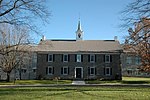Battle of White Marsh

The Battle of White Marsh or Battle of Edge Hill was a battle of the Philadelphia campaign of the American Revolutionary War fought December 5–8, 1777, in the area surrounding Whitemarsh Township, Pennsylvania. The battle, which took the form of a series of skirmish actions, was the last major engagement of 1777 between British and American forces. George Washington, commander-in-chief of the American revolutionary forces, spent the weeks after his defeat at the Battle of Germantown encamped with the Continental Army in various locations throughout upper Philadelphia County (now Montgomery County), just north of the British-occupied city. In early November, the Americans established an entrenched position approximately 16 miles (26 km) north of Philadelphia along the Wissahickon Creek and Sandy Run, primarily situated on several hills between Old York Road and Bethlehem Pike. From here, Washington monitored British troop movements in Philadelphia and evaluated his options. On December 4, Gen. Sir William Howe, the commander-in-chief of British forces in North America, led a sizable contingent of troops out of Philadelphia in one last attempt to destroy Washington and the Continental Army before the onset of winter. After a series of skirmishes, Howe called off the attack and returned to Philadelphia without engaging Washington in a decisive conflict. With the British back in Philadelphia, Washington was able to march his troops to winter quarters at Valley Forge.
Excerpt from the Wikipedia article Battle of White Marsh (License: CC BY-SA 3.0, Authors, Images).Battle of White Marsh
Militia Hill Day Use Area Loop Trail,
Geographical coordinates (GPS) Address Nearby Places Show on map
Geographical coordinates (GPS)
| Latitude | Longitude |
|---|---|
| N 40.12 ° | E -75.23 ° |
Address
Militia Hill Day Use Area Loop Trail
19031
Pennsylvania, United States
Open on Google Maps







